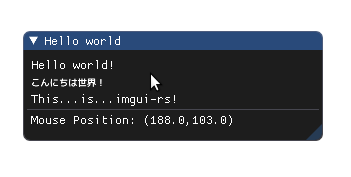Still fairly experimental!
Minimum Rust version: 1.40
Wrapped Dear ImGui version: 1.77
Window::new(im_str!("Hello world"))
.size([300.0, 100.0], Condition::FirstUseEver)
.build(&ui, || {
ui.text(im_str!("Hello world!"));
ui.text(im_str!("こんにちは世界!"));
ui.text(im_str!("This...is...imgui-rs!"));
ui.separator();
let mouse_pos = ui.io().mouse_pos;
ui.text(format!(
"Mouse Position: ({:.1},{:.1})",
mouse_pos[0], mouse_pos[1]
));
});- imgui: High-level safe API
- imgui-glium-renderer: Renderer implementation that uses the
gliumcrate - imgui-gfx-renderer: Renderer implementation that uses the
gfxcrate (not the new gfx-hal crate) - imgui-winit-support: Backend platform implementation that uses the
winitcrate (0.22 by default, but 0.19-0.21 are supported via feature flags) - imgui-sys: Low-level unsafe API (automatically generated)
- Bindings for Dear ImGui that can be used with safe Rust. Note: API coverage is not 100%, but will keep improving over time.
- Builder structs for use cases where the original C++ library uses optional function parameters
&ImStr/ImStringtypes andim_str!macro for defining and passing null-terminated UTF-8 to Dear ImGui, which doesn't accept Rust&str/Stringvalues. See issue #7 for more information and justification for this design.- Easy integration with Glium / pre-ll gfx (renderer)
- Easy integration with winit (backend platform)
Almost every application that uses imgui-rs needs two additional components in
addition to the main imgui crate: a backend platform, and a renderer.
The backend platform is responsible for integrating imgui-rs with the operating system and its window management. Its responsibilities include the following:
- Handling input events (e.g. keyboard, mouse) and updating imgui-rs state accordingly
- Passing information about the OS window (e.g. size, DPI factor) to imgui-rs
- Updating the OS-side mouse cursor when imgui-rs requests it
The renderer is responsible for taking generic, renderer-agnostic draw lists generated by imgui-rs, and rendering them using some graphics API. Its responsibilities include the following:
- Rendering using vertex/index buffers and command lists
- Handling of DPI factors and scissor rects
- Texture management
The most tested platform/renderer combination is imgui-glium-renderer +
glium + imgui-winit-support + winit, but this is not the only possible
combination. There's also imgui-gfx-renderer, and you can find additional 3rd
party crates that provide a wider support for more libraries (e.g. raw OpenGL,
SDL2). You can also write your own support code if you have a more advanced use
case, because imgui-rs is not tied to any specific graphics / OS API.
git clone https://github.com/Gekkio/imgui-rs
cd imgui-rs
git submodule update --init --recursiveMain examples are located in the imgui-examples directory.
# At the reposity root
cd imgui-examples
cargo test
cargo run --example hello_world
cargo run --example test_window
cargo run --example test_window_implExamples for the gfx backend are under the imgui-gfx-examples directory.
cd imgui-gfx-examples
cargo test
cargo run --example hello_world
cargo run --example test_windowNote to Windows users: You will need to use the MSVC ABI version of the Rust compiler along with its associated dependencies to build this libary and run the examples.
-
Change or add something
-
Make sure you're using the latest stable Rust
-
Run rustfmt to guarantee code style conformance
rustup component add rustfmt cargo fmt
-
Open a pull request in Github
Licensed under either of
- Apache License, Version 2.0, (LICENSE-APACHE or http://www.apache.org/licenses/LICENSE-2.0)
- MIT license (LICENSE-MIT or http://opensource.org/licenses/MIT)
at your option.
Uses Dear ImGui and cimgui.
Unless you explicitly state otherwise, any contribution intentionally submitted for inclusion in the work by you, as defined in the Apache-2.0 license, shall be dual licensed as above, without any additional terms or conditions.
